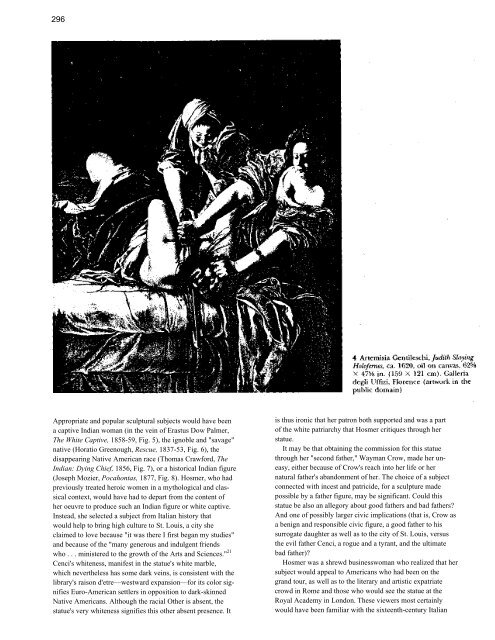of Incest and Female Relations in Harriet Hosmer's Beatrice Cenci
of Incest and Female Relations in Harriet Hosmer's Beatrice Cenci
of Incest and Female Relations in Harriet Hosmer's Beatrice Cenci
Create successful ePaper yourself
Turn your PDF publications into a flip-book with our unique Google optimized e-Paper software.
296<br />
Appropriate <strong>and</strong> popular sculptural subjects would have been<br />
a captive Indian woman (<strong>in</strong> the ve<strong>in</strong> <strong>of</strong> Erastus Dow Palmer,<br />
The White Captive, 1858-59, Fig. 5), the ignoble <strong>and</strong> "savage"<br />
native (Horatio Greenough, Rescue, 1837-53, Fig. 6), the<br />
disappear<strong>in</strong>g Native American race (Thomas Crawford, The<br />
Indian: Dy<strong>in</strong>g Chief, 1856, Fig. 7), or a historical Indian figure<br />
(Joseph Mozier, Pocahontas, 1877, Fig. 8). Hosmer, who had<br />
previously treated heroic women <strong>in</strong> a mythological <strong>and</strong> clas-<br />
sical context, would have had to depart from the content <strong>of</strong><br />
her oeuvre to produce such an Indian figure or white captive.<br />
Instead, she selected a subject from Italian history that<br />
would help to br<strong>in</strong>g high culture to St. Louis, a city she<br />
claimed to love because "it was there I first began my studies"<br />
<strong>and</strong> because <strong>of</strong> the "many generous <strong>and</strong> <strong>in</strong>dulgent friends<br />
who . . . m<strong>in</strong>istered to the growth <strong>of</strong> the Arts <strong>and</strong> Sciences." 21<br />
<strong>Cenci</strong>'s whiteness, manifest <strong>in</strong> the statue's white marble,<br />
which nevertheless has some dark ve<strong>in</strong>s, is consistent with the<br />
library's raison d'etre—westward expansion—for its color sig-<br />
nifies Euro-American settlers <strong>in</strong> opposition to dark-sk<strong>in</strong>ned<br />
Native Americans. Although the racial Other is absent, the<br />
statue's very whiteness signifies this other absent presence. It<br />
is thus ironic that her patron both supported <strong>and</strong> was a part<br />
<strong>of</strong> the white patriarchy that Hosmer critiques through her<br />
statue.<br />
It may be that obta<strong>in</strong><strong>in</strong>g the commission for this statue<br />
through her "second father," Wayman Crow, made her un-<br />
easy, either because <strong>of</strong> Crow's reach <strong>in</strong>to her life or her<br />
natural father's ab<strong>and</strong>onment <strong>of</strong> her. The choice <strong>of</strong> a subject<br />
connected with <strong>in</strong>cest <strong>and</strong> patricide, for a sculpture made<br />
possible by a father figure, may be significant. Could this<br />
statue be also an allegory about good fathers <strong>and</strong> bad fathers?<br />
And one <strong>of</strong> possibly larger civic implications (that is, Crow as<br />
a benign <strong>and</strong> responsible civic figure, a good father to his<br />
surrogate daughter as well as to the city <strong>of</strong> St. Louis, versus<br />
the evil father <strong>Cenci</strong>, a rogue <strong>and</strong> a tyrant, <strong>and</strong> the ultimate<br />
bad father)?<br />
Hosmer was a shrewd bus<strong>in</strong>esswoman who realized that her<br />
subject would appeal to Americans who had been on the<br />
gr<strong>and</strong> tour, as well as to the literary <strong>and</strong> artistic expatriate<br />
crowd <strong>in</strong> Rome <strong>and</strong> those who would see the statue at the<br />
Royal Academy <strong>in</strong> London. These viewers most certa<strong>in</strong>ly<br />
would have been familiar with the sixteenth-century Italian
















